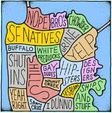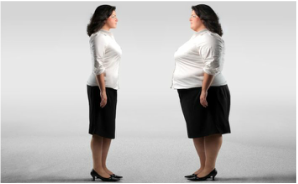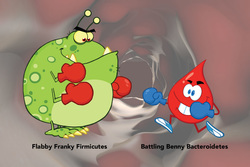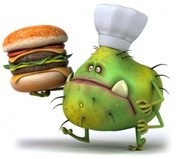

Similarly to skilled immigrants able to strengthen economy of the city, transfer of gut microbes from lean to obese individuals could potentially transform the management of obesity. The devil is in the details, however, and we still have a lot to learn before developing such therapies, including the ability to match donors and recipients.
Single-strain probiotics might work better than some multi-strain compositions. But developing microbiome-based remedies is more complicated than picking one type of bacteria or compiling a small list of "good microbes" and slightly tweaking it from person to person. Even for mice whose weight gain and loss patterns are much simpler than human, transfer of 39 types of microbes from lean to obese organisms did not help, but expanding it to 54 did the trick.

Four races - aka bacterial phyla Firmicutes, Bacteroidetes, Proteobacteria, and Actinobacteria - account for the majority of bacterial nations present in the human gut (Khanna and Tosh, 2014). Typically ~60% of the bacteria present in the human gut are either gram positive Bacteroidetes or gram negative Firmicutes (2005). Other major groups - Actinobacteria and Proteobacteria - can be substantially more abundant in cases like inflammatory bowel disease. The gut microbial composition is distinctive in obese individuals and is associated with reduced numbers of Bacteroidetes and increased numbers of Firmicutes, in mice (2005) and in humans (2011, 2012). These changes have significant implications for energy homeostasis, as a 20% increase in Firmicutes and a corresponding 20% decrease in Bacteroidetes is estimated to provide an additional 150 kcal of energy per day to an adult human (2011).
But losing weight is not as easy as nourishing Bacteroidetes and eradicating Firmicutes, as each of these groups contains thousands of species with different roles in the gut.


The most commonly found gut bacteria genera in adults, Bifidobacterium, Lactobacillus, Bacteroides, Clostridium, Escherichia, Streptococcus, and Ruminococcus (Conlon and Bird, 2015) produce a vast range of microbial products that include enzymes for carbohydrate metabolism (Xu et al., 2003), short chain fatty acids (SCFA) (Bergman, 1990), lipopolysaccharide (LPS) (Munford, 2008), and secondary bile acids (Nicholson et al., 2012). . Individually and collectively, these bacteria contribute to energy flux, or cause inflammation and other complications (Tehrani et al., 2012; Trompette et al., 2014).

Microbes alone won't help us lose weight without exercising and eating right, but identifying the right species and enlisting their help might make a difference, paving the way to truly personalized nutrition and weight management.
Vanessa K. Ridaura, Jeremiah J. Faith, Federico E. Rey, Jiye Cheng, Alexis E. Duncan, Andrew L. Kau, Nicholas W. Griffin, Vincent Lombard, Bernard Henrissat, James R. Bain, Michael J. Muehlbauer, Olga Ilkayeva, Clay F. Semenkovich, Katsuhiko Funai, David K. Hayashi, Barbara J. Lyle, Margaret C. Martini, Luke K. Ursell, Jose C. Clemente, William Van Treuren, William A. Walters, Rob Knight, Christopher B. Newgard, Andrew C. Heath, Jeffrey I. Gordon Cultured gut microbiota from twins discordant for obesity modulate adiposity and metabolic phenotypes in mice Science. 2013 September 6; 341(6150): 10.1126/science.1241214. doi: 10.1126/science.1241214 PMCID: PMC3829625
Thilini N. Jayasinghe, Valentina Chiavaroli, David J. Holland, Wayne S. Cutfield, Justin M. O'Sullivan
Front Cell Infect Microbiol. The New Era of Treatment for Obesity and Metabolic Disorders: Evidence and Expectations for Gut Microbiome Transplantation 2016; 6: 15. Published online 2016 February 19. doi: 10.3389/fcimb.2016.00015 PMCID: PMC4759265
Karimi, Golgis et al. The anti-obesity effects of Lactobacillus casei strain Shirota versus Orlistat on high fat diet-induced obese rats. Food & Nutrition Research 2015, 59: 29273 http://dx.doi.org/10.3402/fnr.v59.29273
Million M, Thuny F, Angelakis E, Casalta JP, Giorgi R, Habib G, Raoult D. Lactobacillus reuteri and Escherichia coli in the human gut microbiota may predict weight gain associated with vancomycin treatment.Nutr Diabetes. 2013;3:e87.
Armougom F, Henry M, Vialettes B, Raccah D, Raoult D. Monitoring bacterial community of human gut microbiota reveals an increase in Lactobacillus in obese patients and Methanogens in anorexic patients. PLoS One. 2009;4:e7125.
Million M, Angelakis E, Paul M, Armougom F, Leibovici L, Raoult D. Comparative meta-analysis of the effect of Lactobacillus species on weight gain in humans and animals. Microb Pathog. 2012 Aug;53(2):100-8. doi: 10.1016/j.micpath.2012.05.007. Epub 2012 May 24.
Jaclyn M. Omara, Yen-Ming Chana, Mitchell L. Jonesb, c, Satya Prakashb, c, Peter J.H. Jonesa
Lactobacillus fermentum and Lactobacillus amylovorus as probiotics alter body adiposity and gut microflora in healthy persons. Journal of Functional Foods Volume 5, Issue 1, January 2013, Pages 116–123
Sanchez et al. Effect of Lactobacillus rhamnosus CGMCC1.3724 supplementation on weight loss and maintenance in obese men and women. Br J Nutr. 2014 Apr 28;111(8):1507-19. doi: 10.1017/S0007114513003875. Epub 2013 Dec 3.
Conlon, M. A., Bird, A.R. The Impact of Diet and Lifestyle on Gut Microbiota and Human Health
Nutrients. 2015 Jan; 7(1): 17–44. Published online 2014 Dec 24. doi: 10.3390/nu7010017
Alang, N., & Kelly, C. (2015) Weight Gain After Fecal Microbiota Transplantation. Open Forum Infectious Diseases, 2(1). DOI: 10.1093/ofid/ofv004


 RSS Feed
RSS Feed
